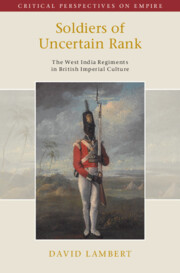Book contents
- Soldiers of Uncertain Rank
- Critical Perspectives on Empire
- Soldiers of Uncertain Rank
- Copyright page
- Dedication
- Contents
- Figures
- Acknowledgements
- Abbreviations
- 1 Race, Military Spectacle and the West India Regiments
- 2 The Spectre of a Black Soldiery
- 3 Establishing the Steady Black Soldier
- 4 The Reorientation of the West India Regiments
- 5 Displaying Valour
- 6 Neither Soldiers nor Warriors
- 7 Bringing the Troops Home
- 8 Remembering the West India Regiments
- Bibliography
- Index
6 - Neither Soldiers nor Warriors
Published online by Cambridge University Press: 17 October 2024
- Soldiers of Uncertain Rank
- Critical Perspectives on Empire
- Soldiers of Uncertain Rank
- Copyright page
- Dedication
- Contents
- Figures
- Acknowledgements
- Abbreviations
- 1 Race, Military Spectacle and the West India Regiments
- 2 The Spectre of a Black Soldiery
- 3 Establishing the Steady Black Soldier
- 4 The Reorientation of the West India Regiments
- 5 Displaying Valour
- 6 Neither Soldiers nor Warriors
- 7 Bringing the Troops Home
- 8 Remembering the West India Regiments
- Bibliography
- Index
Summary
Chapter 6 is concerned with the role of the West India Regiments in maintaining and expanding Britain’s African empire in the final decades of the nineteenth century. The particular focus is the 1873-74 Anglo-Asante War, the first colonial campaign to capture the British public’s imagination and one which made a household name of commanding officer Garnet Joseph Wolseley (1833-1913). The Asante were among Britain’s most consistent antagonists in the imperial theatre and held a long-standing place within European discourses of African ‘savagery’. Warfare against them was cast as an interracial struggle. However, the involvement of the West India Regiments complicated this picture and the chapter compares the depiction of the regiments’ soldiers with that of Britain’s Asante enemies and local Fante allies. It also considers the military role allotted to the West India Regiment soldiers as the campaign developed, including the fact that they were used as baggage-handlers for the White regiments during the final march on Kumasi and were not permitted to enter the Asante capital. This shows that the way in which their constrained martial image, such that they were neither White ‘soldiers’ nor African ‘warriors’, had consequences in the military field.
Keywords
- Type
- Chapter
- Information
- Soldiers of Uncertain RankThe West India Regiments in British Imperial Culture, pp. 144 - 173Publisher: Cambridge University PressPrint publication year: 2024

